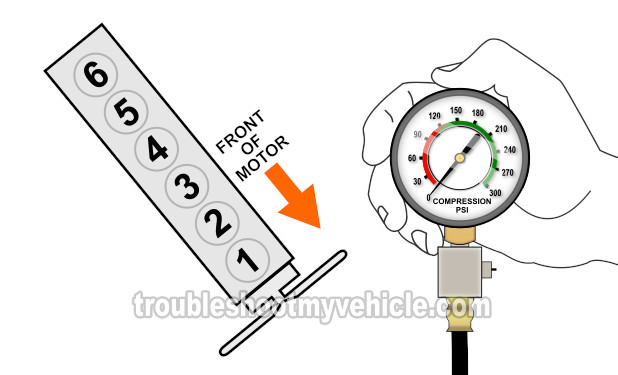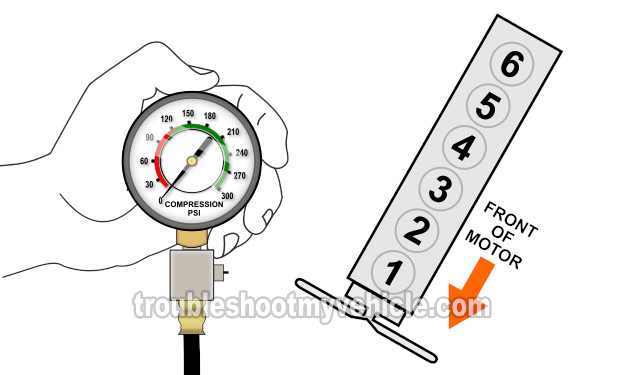
In this tutorial, I'm going to show you how to test the engine compression on the 4.2L equipped 2002-2009 Chevrolet TrailBlazer or GMC Envoy.
The engine compression test will help you troubleshoot a hard to diagnose misfire condition and its accompanying misfire trouble code.
The compression test will also help you troubleshoot a no-start condition if its due to internal engine problems.
Contents of this tutorial:
ES ![]() You can find this tutorial in Spanish here: Cómo Probar La Compresión Del Motor (2002-2009 4.2L Chevrolet TrailBlazer) (at: autotecnico-online.com).
You can find this tutorial in Spanish here: Cómo Probar La Compresión Del Motor (2002-2009 4.2L Chevrolet TrailBlazer) (at: autotecnico-online.com).
Symptoms Of Low Or No Compression
Engine compression issues can manifest in various ways and can significantly impact the performance and reliability of a vehicle. Let's break down the details:
Low Compression or Zero PSI Compression:
- Low Compression in Some but Not All Cylinders: Low compression in one or more cylinders means that the cylinders are not generating sufficient pressure during the compression stroke. This can be caused by worn piston rings, damaged cylinder walls, or leaking valves.
- Zero PSI Compression in Some or All Cylinders: Zero PSI compression indicates a complete failure of compression in one or more cylinders, which can be caused by severe engine damage such as a blown head gasket or catastrophic piston failure.
Regardless of whether the compression is low or zero, you'll notice several symptoms that indicate there's an issue with the engine's compression:
- Hard Starting or No Start: Reduced compression can make it difficult for the engine to start, or it may not start at all.
- Poor Engine Performance: Decreased compression leads to weakened power output and overall poor engine performance.
- Cylinder Misfire Issues: Compression issues can cause misfires in one or more cylinders, resulting in rough idling and poor acceleration. You'll see one or more of the following misfire codes stored in the PCM's memory:
- P0301: Random Cylinder Misfire.
- P0302: Cylinder Number 2 Misfire.
- P0303: Cylinder Number 3 Misfire.
- P0304: Cylinder Number 4 Misfire.
- P0305: Cylinder Number 5 Misfire.
- P0306: Cylinder Number 6 Misfire.
- Reduced Power and Performance: The engine may lack the power it needs for proper acceleration and performance due to inadequate compression.
- Excessive Oil Consumption: Compression problems can lead to oil leaks into the combustion chamber, resulting in increased oil consumption.
- Blue Smoke Coming From The Tailpipe: This can be a sign of piston ring wear, valve seal failure, or other internal engine issues related to compression.
- Audible Engine Noise: Issues like piston slap or valve noise may become more pronounced due to reduced compression.
Important Tips And Suggestions
TIP 1: The spark plugs have to be removed from the engine to test its compression. It's important you do not remove the spark plugs from a hot engine.
If the engine has been running for any length of time, on your 4.2L Chevrolet TrailBlazer or GMC Envoy, you need to let it cool down for at least an hour before attempting to remove the spark plugs.
Attempting to remove the spark plugs from a hot engine can damage the threads in the spark plug holes. This is a nightmare you want to avoid.
TIP 2: If you find that the spark plugs are swimming in engine oil, as you're removing them from their spark plug tubes, you'll need to replace the valve cover gasket.
If the spark plugs are soaked in engine oil, it's important to replace them with new ones.
If the spark plug boots on the ignition coils, are soaked in engine oil, it's important to replace them too.
Which Compression Tester Should I Buy?
There are lot of engine compression testers to choose from and many places to buy them. I'm gonna' make some recommendations to you:
Disclosure: As an Amazon Associate, I earn from qualifying purchases. If my tutorials help you, using these links is an easy way to support the site at no extra cost to you. Thank you!
TEST 1: Dry Compression Test

I have divided the compression test into two parts. In this first part we're going to test the compression of all 6 cylinders.
In the second part, which is in the next page, we're going to test only the cylinders that have low engine compression.
Depending on the amount of wear and tear and mileage on your 4.2L engine, you'll see some of the cylinders with compression values that are lower than the majority.
Up to a certain point this is normal, since engine cylinders do not wear out at the exact same rate. Figuring out if these compression values are causing a problem is not hard and I'll explain how to find out.
Let's get testing:
- 1
Remove the ignition coils.
- 2
Remove the spark plugs.
When removing the spark plugs, be careful not to drop any of them on the floor, or you run the risk of having the spark plugs porcelain insulator crack and then you'll have a misfire on your hands. - 3
Thread the engine compression gauge into the spark plug hole for the number 1 engine cylinder.
Hand tighten the compression gauge only! Do not use any type of tool to get it tight. - 4
Have your helper crank the engine till the needle on the compression gauge stops climbing.
- 5
Record the value at which the needle stopped and the number of the engine cylinder on a piece of paper.
- 6
Repeat steps 3-5 on the remaining cylinders.
Let's take a look at what your compression test results mean:
CASE 1: You got 0 PSI in the majority of the cylinders. This tells you your Chevy TrailBlazer or GMC Envoy's engine has serious internal problems. This is usually due to:
- Busted timing chain.
- Engine threw a rod.
Any compression value below 100 PSI (even if it's not 0 PSI) means internal mechanical engine trouble.
CASE 2: All cylinders have compression, but their values are not the same. It's normal for each cylinder's compression value to vary slightly from one another. But if they vary too much, you'll have a bonafide misfire or rough idle condition on your hands.
To find out, the next step is to go to: Calculating The Compression Values To See If They Are Within Range.
Calculating The Compression Values To See If They Are Within Range
It's not unusual to see compression values that are not similar when doing an engine compression test (particularly in high-mileage engines).
This is usually not a cause for concern since engine cylinders do not wear out at the exact same rate as time and miles accumulate on your Chevrolet TrailBlazer or GMC Envoy's engine.
When a low engine compression value does cause a problem, it's when its compression value varies more than 15% from the highest engine compression value.
You can do this (figuring out the 15%) in one of two ways: You can calculate this 15% difference with pen and paper or use my low compression calculator.
If you want to use the calculator, you can find it here: Online Low Engine Compression Calculator (at: easyautodiagnostics.com).
If you want to manually calculate the 15% difference, here's what you'll need to do:
- STEP 1: Multiply the highest compression value by 0.15 (this is the decimal value of 15%).
- STEP 2: Round the result to the nearest one (for example: 25.6 would become 26).
- STEP 3: Subtract the result (the number that was rounded) from the highest compression value.
- ANSWER: The result of this subtraction is the lowest possible compression value any cylinder can have.
Now, let me give you a more specific example: Let's say I got the following compression readings:
| Cylinder | Pressure |
|---|---|
| #1 | 165 PSI |
| #2 | 95 PSI |
| #3 | 155 PSI |
| #4 | 175 PSI |
| #5 | 175 PSI |
| #6 | 170 PSI |
My next step is to do the following calculation:
- STEP 1: 175 x 0.15 = 26.25.
- STEP 2: 26.25 = 26 (rounded to nearest one).
- STEP 3: 175 - 26 = 149.
- ANSWER: 149 PSI. Any cylinder with this compression (or lower) value will misfire.
Since cylinder #2 is only producing 95 PSI, I can now conclude it's 'dead' and causing a misfire.
To find out if the lowest compression value you got from your engine compression test is within a good range, you'll need to do the same calculation. Of course, you'll need to use the highest compression value you got and not the one in the example.
Once you've found the 'dead' cylinder, the next step is to find out what's causing the low compression value. For this step, go to: TEST 2: Wet Compression Test.
TEST 2: Wet Compression Test
A cylinder will produce a low engine compression value if it has a problem with its piston rings or its cylinder head valves.
The cool thing is we don't have to remove and disassemble the engine to find out where the problem lies.
How? You might be wondering. Well, we can do this by adding a small amount of engine oil into the cylinder with low compression and retesting its compression.
If the low compression problem is due to worn-out piston rings, the oil we add to the cylinder will cause the compression reading to shoot up.
If the compression value does not increase, after adding oil to the low compression cylinder, then we can conclude the problem is due to worn-out or damaged cylinder head valves.
These are the test steps:
- 1
Add a tablespoon (or two) of engine oil in the cylinder you need to retest.
Use a funnel to make sure the oil reaches the inside of the cylinder. - 2
Install the compression gauge on the cylinder and hand tighten it.
- 3
Have your helper crank the engine till the needle stops climbing on the compression gauge.
- 4
You'll see one of two results:
1.) The needle will climb higher than the previous compression number you recorded for this specific cylinder.
2.) The needle will not move at all or stay at the same number you recorded earlier. - 5
Write the compression value down.
- 6
If you have another cylinder to test, repeat steps 1 thru' 4 on it now.
Let's take a look at what test results mean:
CASE 1: The compression value increased. This tells you the low compression problem is due to worn piston compression rings.
CASE 2: The compression value DID NOT increase (in other words, it stayed the same). This result tells you the low compression value registered in this cylinder (in the dry test) is due to worn/damaged cylinder head valves.
More GM 4.2L Test Tutorials
If this tutorial was helpful/informative, you can find a complete list of tutorials here:
Here's a sample of the tutorials you'll find there:
- How To Test For A Blown Head Gasket (2002-2009 4.2L Chevrolet TrailBlazer).
- How Often Should I Replace The Spark Plugs? (2002-2009 4.2L Chevrolet TrailBlazer).
- How To Test APP Sensor 1 And 2 (2002-2003 4.2L Chevrolet TrailBlazer).
- Electronic Throttle Body Tests (2002-2007 4.2L Chevrolet TrailBlazer, GMC Envoy).

If this info saved the day, buy me a beer!





